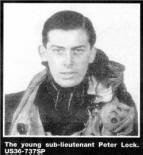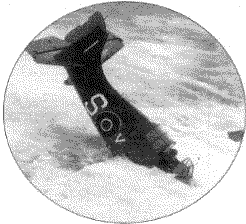
THE MIRACULOUS ESCAPE
FROM PORTMORE LOUGH 'SPLASHDOWN'
Peter lock describes how flames entered the cockpit as he decided to ditch his aircraft
 THE
moment when the a burning aircraft ditched into Portmore Lough
during the Second World War was vividly recalled this week
when the pilot came back to the scene of the horrific
incident.
THE
moment when the a burning aircraft ditched into Portmore Lough
during the Second World War was vividly recalled this week
when the pilot came back to the scene of the horrific
incident.
The crash at Ballinderry nearly 60 years ago is still a strong memory for local people and in Moira on Monday night Sub Lieutenant Peter Lock of the Fleet Air Arm told his story to a meeting in St. John's Parish Centre.
It was organised jointly by Killultagh and Lisburn Historical Societies and the Ulster Aviation Society.
He also took time during his visit here to tell the Star how he made the emergency 'water landing' on Christmas Eve 1944 as flames from the burning engine of his Wildcat aircraft entered its single seater cockpit burning his arms.
Despite being in the thick of wartime action, the incident did not occur as a result of enemy fire but because of a technical mistake at Long Kesh Airfield where his squadron was enjoying a rest from its duties on the aircraft carrier 'Searcher'.
 |
| At the meeting in Moira
were David Twigg, Ernie Cromie, Ramond McMullan, Ann
Stevenson, Peter Lock, Raymond Burroughs and Finny
O'Sullivan. US38-4551T |
Mr. Lock said during these very welcome rest periods the aircraft and their pilots were based at an airfield while the ship docked in the nearest available port. "We used Long Kesh from time to time when we came down through the Irish Sea because it was a handy airfield with a couple of decent hangars," Mr. Lock recalled.
"We staved there for several weeks in December 1944 and a lot of maintenance work was done by ground crews on the aircraft."
The former pilot explained he mid his fellow flyers were often told by their Commanding Officer during these rest periods to make practice flights when they brushed up on techniques used in the conflict at sea such as dive bombing enemy ships.
"On this occasion he sent another plane with me and said to go and do some practice dive bombing on Lough Neagh," recalled Mr. Lock.
"So we lined up and took off. Just as I climbed to between 800 and 900 feet the engine exploded."
 It
transpired that when his Wildcat had been serviced at Long
Kesh a mechanic had failed to re-attach a firing line when he
replaced a spark plug.
It
transpired that when his Wildcat had been serviced at Long
Kesh a mechanic had failed to re-attach a firing line when he
replaced a spark plug.
The engine had functioned well enough to allow him to take off, but by the time he got to 800 feet the engine cowling had been full of gasoline vapour.
A spark caused a 'massive explosion' which blew up the entire motor.
"The explosion was huge and actually twisted the cockpit canopy," Mr. Lock recalled.
"The first thing I thought about was getting out and using my parachute. However, I was only 900 feet off the ground so it might not have opened properly and I could have come to earth with a bang."
He knew that if he released his safety harness to move the canopy he may not have time to put it back on before the plane hit the ground.
He also faced the added problem that every time he touched the throttle it fed more gasoline to the fire which meant flames entered the cockpit.
"They burned the cuffs of my shirt and singed my arms," he said.
"However, our training was very thorough and I realised immediately I had to get the plane down without the motor.
"I had to find some water and I was on my way to Lough Neagh so I turned off the throttle and continued to glide downwards.
"The wheels were up and I finally made it to the edge of Portmore Lough. I don't think I would actually have made it as far as Lough Neagh itself.
"I managed to make a belly landing on the water and as I did so the canopy came off the plane.
"My head hit one of the controls and I was knocked out for five or 10 seconds."
When Mr. Lock came round the plane was beginning to settle in the water.
He couldn't swim but fortunately Portmore Lough was relatively shallow at the time and part of die aircraft remained above the surface.
When Mr. Lock came round the plane was beginning to settle in the water.
He couldn't swim but fortunately Portmore Lough was relatively shallow at the time and part of the aircraft remained above the surface.
 He climbed out of the cockpit and sat on top of the plane
Three or four young members of the Kane family were playing
nearby and one boy who was on the roof of the family's barn
saw the plane land in the water.
He climbed out of the cockpit and sat on top of the plane
Three or four young members of the Kane family were playing
nearby and one boy who was on the roof of the family's barn
saw the plane land in the water.
"This was Christmas Eve and the water was very cold," recalled Mr. Lock. "They rowed out in a boat and picked me up. The pilot of the other plane thought I must have been killed and radioed Long Kesh to ask them to send an ambulance which he believed was going to collect my body.
"It was there when I reached the shore and it took me back to the airfield."
However, Mr. Lock was left with a permanent reminder of the incident.
"In the navy there is a tradition that the officers serve Christmas dinner to the men on Christmas Eve and the gesture is reciprocated on Christmas Day," he said.
"During the afternoon, before the flight, I had changed into my new uniform for Christmas dinner - I had bought the uniform at Jeeves in London just a few weeks previously.
"I didn't want to have to rush to get changed when I landed as dinner was at 6pm. However, I had on my Mae West (lifejacket) and it had a square of fluorescent material on it which gave off a yellow dye when it made contact with the water.
"The idea was to make people easy to fund after a ditching as the dye spread out around you in the sea.
"Of course this happened as soon as it made contact with the water in Portmore Lough and my beautiful new uniform turned yellow.
"I had it cleaned about four times but the dye never really went away."
Mr. Lock moved to Canada during the 1950s and now divides his time between there and his second home in Lancashire.
However, his wartime flying experiences mean he works closely with the Ulster Aviation Society and he attended their Langford Lodge open days on Saturday and Sunday. The aircraft which he landed in Portmore Lough all those years ago was restored by the society during the 1980s and Mr Lock chatted with people viewing the plane.
Next month he will return to Canada where he is moving home but will travel back to Europe later to enjoy some winter sun relaxation in destinations Such as Portugal and Cyprus.
17/09/2004

